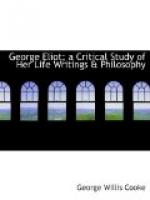While assisting Mr. Chapman, Marian Evans contributed only one article, beyond her editorial work, to the pages of the Westminster Review. The work she did, almost wholly that of digesting and reviewing new books, could have been little to her taste. It must have been a drudgery, except in so far as it aided her in the pursuit of her studies. Occasionally, however, she must have found a task to her mind, as when, in the summary of current English literature for January, 1852. she had Carlyle’s Life of Sterling in hand. Her notice of the book is highly appreciative of Carlyle’s genius, and full of cordial praise. This passage gives her idea of a true biography:
We have often wished that genius would incline itself more frequently to the task of the biographer,—that when some great or good personage dies, instead of the dreary three or five volumed compilations of letter, and diary, and detail, little to the purpose, which two-thirds of the reading public have not the chance, nor the other third the inclination, to read, we could have a real “Life,” setting forth briefly and vividly the man’s inward and outward struggles, aims and achievements, so as to make clear the meaning which his experience has for his fellows. A few such lives (chiefly, indeed, autobiographies) the world possesses, and they have, perhaps, been more influential on the formation of character than any other kind of reading. But the conditions required for the perfection of life writing,—personal intimacy, a loving and poetic nature which sees the beauty and the depth of familiar things, and the artistic power which seizes characteristic points and renders them with life-like effect,—are seldom found in combination. The Life of Sterling is an instance of this rare conjunction. Its comparatively tame scenes and incidents gather picturesqueness and interest under the rich lights of Carlyle’s mind. We are told neither too little nor too much; the facts noted, the letters selected, are all such as serve to give the liveliest conception of what Sterling was and what he did; and though the book speaks much of other persons, this collateral matter is all a kind of scene-painting, and is accessory to the main purpose.
The earliest of the regular articles, and the only one printed while she was the associate editor of the Review, is on “The Lady Novelists.” It appeared in the number for July, 1852, and contained a striking discussion of woman’s place in literature, a defence of woman’s right to occupy that field she can best cultivate, with a clear and just criticism of several of the most prominent among lady novelists. She was quite full in her treatment of Jane Austen and George Sand, praising as well as criticising with insight and fine discrimination. At the outset she defines literature as an expression of the emotions, and gives a remarkably clear and original description of its functions.




